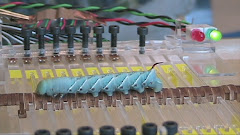Taking the 3D wiring approach, I successfully customized a micro-RC system for my robots. Traditional electronics are limited by the 2D wiring of PCB boards. Making thin electronics is easy as long as the integrated circuits utilize the surface on the PCB efficiently. That's why cellphones and iPods can be so thin. However, if bulk size is an issue (my robots need to fit through a small hole), traditional circuit layout cannot accommodate that down to a critical size. The only solution to improve packing is to do away with any sort of PCB and stack integrated circuits one on top of each other. By fitting these electronics components carefully according to their geometry, one can minimize the overall dimensions. This is exactly what I did.
Well, piecing 3D puzzles is only the first step. Since overall dimension has to be as small as possible, I worked with the smallest of everything from diodes to wires. I started with the World's smallest RC receiver and built on top of that. Typical soldering dot size is less than 500 micron and most soldering joint spacing is 800 micron. Due to the complex 3D structure, wiring and insulation became very complicated. All the wiring and soldering has to be done manually under a microscope. My micro-dissection skills really came to the rescue!! This is perhaps a good example of how human beats machines. [the scale in the following images is mm]

The result was quite satisfactory. I could radio control 7 actuators on my robot with all the electronics packed into a ~6mm cube volume (not including external wires) over a 300 meters range. The customized transmitter can receive commands from a computer interface via a USB cable. This allows the robot operator to gain various computer support including an library of CPG gaits. Image below showed a test setup where actuators were distributed across several different worm-like bodies.


.jpg)
nice job HT :)
ReplyDeleteWait until I get sensory feedback on the robots!!
ReplyDelete